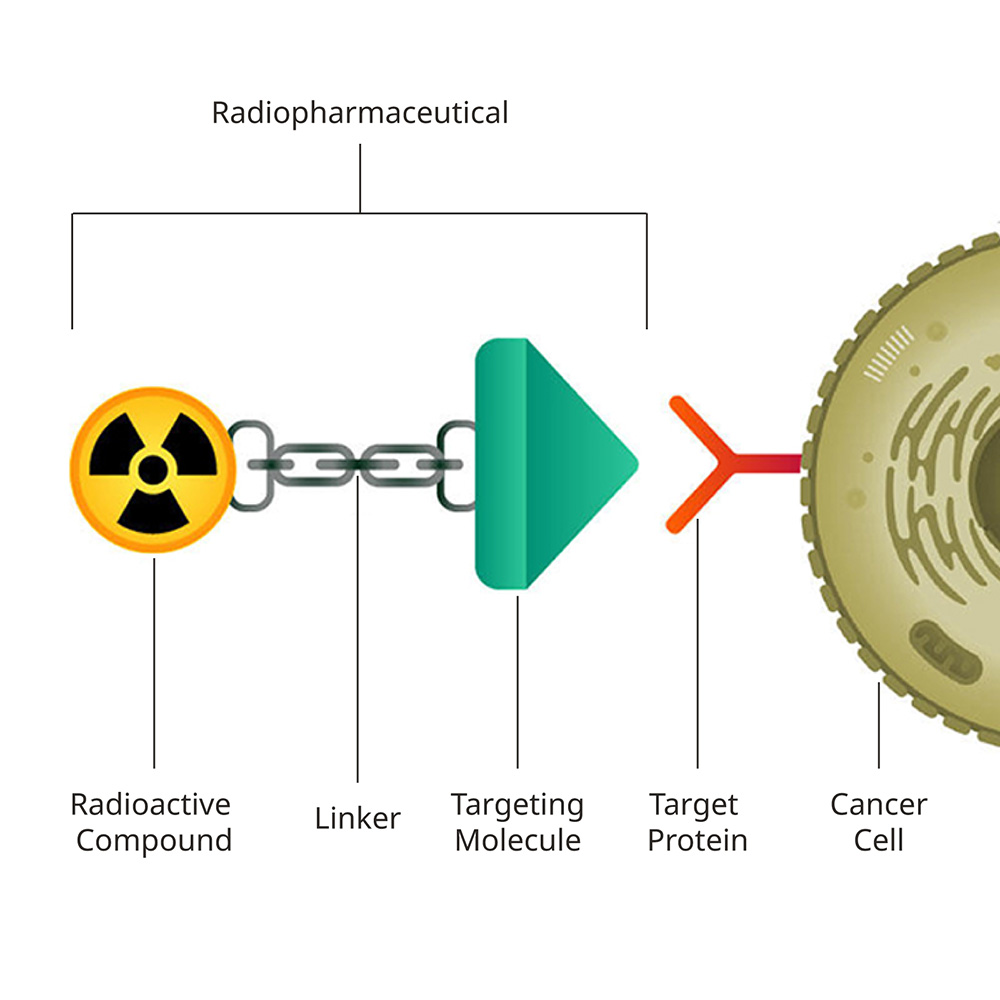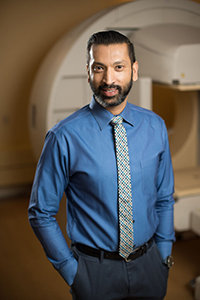Nuclear Medicine to Treat Cancer

Nuclear medicine is a powerful way to treat cancer. It uses special radioactive drugs called radiopharmaceuticals that seek out and destroy cancer cells. Doctors use it to treat several types of cancer, and are working to add many more in the future.
The OHSU Knight Cancer Institute is a leader in this therapy:
- We have deep expertise and offer all radioactive drugs approved by the Food and Drug Administration.
- Our research helped some of these drugs earn FDA approval.
- We’re conducting clinical trials to see if radioactive drugs can treat more types of cancer.
- We’re designated a Center of Excellence by the Society of Nuclear Medicine and Molecular Imaging.
What is nuclear medicine therapy?
Nuclear medicine combines the precision of targeted therapy with the power of radiation therapy. It uses radioactive drugs called radiopharmaceuticals. These drugs home in on cancer cells and bombard them with radiation, causing them to stop growing or die.
Doctors have been using nuclear medicine for decades. But new technology is creating new therapies and giving patients more options than ever before.
Nuclear medicine is used together with other types of treatment to have the greatest effect. That’s because the therapies pack more punch when used together.
Radioactive drugs do not glow. But you will emit radiation for a few days. Your care team will provide instructions to keep you and your family safe.
Benefits of nuclear medicine
- It targets cancer cells, with less damage to healthy cells.
- It delivers a steady dose of radiation over several days.
- It can treat cancer that is resistant to other types of therapy.
- It can boost the power of other therapies.
- It is not invasive.
Limits of nuclear medicine
- It doesn’t work for every type of cancer.
- It can’t be used if you’re pregnant.
- It raises your exposure to radiation.
- Like most other cancer drugs, it can cause serious side effects.
Radiopharmaceutical

How does nuclear medicine work?
Nuclear medicine uses radioactive drugs to target cancer cells but not healthy cells. The drug has three parts: a head, a body and a tail. Once it enters the bloodstream, the head seeks out cancer cells the way a bumblebee seeks flowers.
Then the tail delivers the sting: a radioactive atom that bombards the cancer cell with radiation, causing it to stop growing or die.
The drug hits the cancer cells with radiation for many days before slowly wearing off. After that, the drug breaks down and is flushed from the body.
How is nuclear medicine given?
Most radioactive drugs are given through an IV. Some only take a minute, others several hours. Most can be done as an outpatient while some may require a hospital admission.
At the Knight Cancer institute, this therapy is given by doctors in our Nuclear Medicine clinic on Marquam Hill.
Nuclear medicine is different from external radiation therapy. In nuclear medicine, the radiation comes from a drug inside your body. In external radiation therapy, it comes from a machine outside your body. Depending on your needs, you may get both types of therapy, at different times.
How safe is nuclear medicine?

Doctors have used radioactive drugs for cancer and other conditions since 1941. Since then, thousands of people have benefited from this therapy.
Radiation can pose health risks, however. Most commonly, this can temporarily reduce your bone marrow counts. Some studies have suggested a link between radioactive drugs and a slight increase in your cancer risk. But the biggest and most comprehensive study, done in 2021, concluded that any risks are tiny.
We take many precautions to limit your radiation exposure. Your team will explain them.
Radioactive drugs lose most of their radioactivity within a few days. They are typically flushed out of the body when you sweat and use the toilet. Your team will give you advice on simple ways to limit exposure to yourself and others.
What types of cancer do we treat with nuclear medicine?
- Prostate cancer: Researchers at the Knight found that radioactive drugs can treat a resistant type of prostate cancer. Learn how we treat prostate cancer.
- Neuroendocrine tumors: Researchers at the Knight found that radioactive drugs can treat NETs that have spread. Learn how we treat NETs.
- Bone cancer: Cancer that has spread to bones can be hard to treat. A radioactive drug named Xofigo targets cancer cells in bones by mimicking the calcium they need. The cancer cells absorb the Xofigo and are poisoned by the radiation. This treatment can be used to treat advanced prostate cancer that has spread to bones.
- Liver cancer: Doctors can sometimes treat tumors in the liver with tiny radioactive beads. Learn about how we treat liver cancer.
- Thyroid cancer: Doctors usually use surgery to remove all or part of your thyroid gland. Then they use a radioactive drug to home in on any remaining cancer cells. Learn about how we treat thyroid cancer.
- Non-Hodgkin lymphoma: Doctors usually treat this condition with chemotherapy. But they can also use a radioactive drug that combines a radioactive atom with immunotherapy. Learn how we treat lymphoma.
Clinical trials
We are involved with several clinical trials in this field.
Targeted alpha therapy
Most radioactive drugs emit beta particles. Beta particles are small and light. It takes them a while to kill a cancer cell.
But researchers are working on drugs that emit alpha particles. Alpha particles are 8,000 times more massive than beta particles and can kill a cancer cell in one hit. Doctors think targeted alpha therapy has the potential to help more people with cancer, but making these drugs is challenging.
Researchers at the Knight are looking into treating NETs with an experimental drug named RYZ101. It combines a targeted therapy with a new radioactive isotope that emits alpha particles.
Targeted matrix therapy
Tumor cells need a matrix to grow. A matrix is like the scaffolding that helps workers build a house. At the cellular level, this scaffolding has a signature that can be a target.
Researchers are working on a drug that targets this scaffolding to focus radiation on tumor cells. This approach may help patients with many different types of cancer.
Other names
Nuclear medicine therapy is a rapidly changing field and has many names, including:
- Radiopharmaceutical therapy
- Radionuclide therapy
- Peptide receptor radionuclide therapy (PRRT)
- Radioligand therapy
- Theranostics
Learn more
- Radiation Therapy Enters the Molecular Age, National Cancer Institute
- New Cancer Treatment: Radiopharmaceuticals, McMaster Demystifying Medicine
- Radioiodine Therapy for Hyperthyroidism Presents No Longterm Cancer Risk, EndocrineWeb
Refer a patient
- Refer your patient to OHSU.
- Call 503-494-4567 to seek provider-to-provider advice.
Location
Molecular Imaging and Therapy Clinic
Mark O. Hatfield Research Center, 14th floor
3250 S.W. Sam Jackson Park Road
Portland, Oregon 97239
Free parking for patients and visitors
Learn more about OHSU Knight Cancer Institute treatments:
Stay informed
News: Read about research breakthroughs, patient care and many other topics on the OHSU News site.